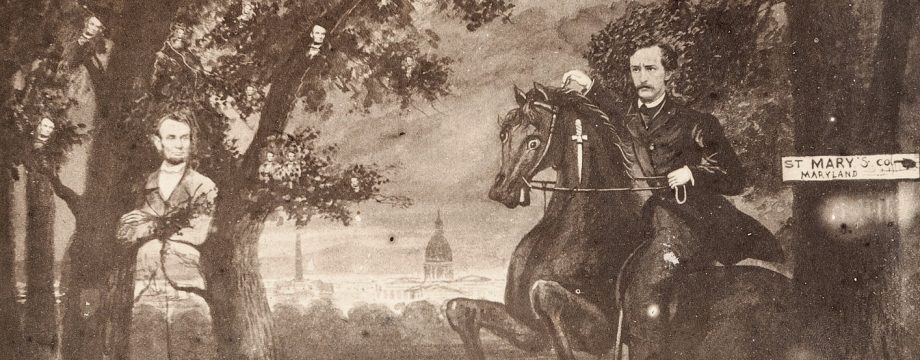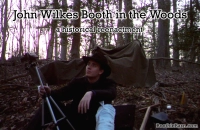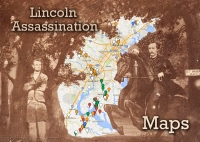On select Thursdays we are highlighting the final resting place of someone related to the Lincoln assassination story. It may be the grave of someone whose name looms large in assassination literature, like a conspirator, or the grave of one of the many minor characters who crossed paths with history. Welcome to Grave Thursday.
William Frederick Keeler

Burial Location: Arlington National Cemetery, Arlington, Virginia

Connection to the Lincoln assassination:
In 1865, William Keeler was a naval officer serving as assistant paymaster on board the USS Florida. Keeler’s military service had started in 1862 when he was assigned as acting paymaster of the Union’s first ironclad warship, the USS Monitor. Keeler was aboard the Monitor during its battle with CSS Virginia (the former USS Merrimack) which ended in a stalemate between the ironclads. In his correspondences with his wife, Keeler wrote about the battle and his own role of passing orders from the Captain to the men stationed at the gun turrets. Keeler was still stationed aboard the Monitor when the ship floundered and sank in December of 1862. The paymaster was one of the lucky few who were saved from drowning. After the loss of the Monitor, Keeler was transferred to the Florida, a sidewheel steamship. While aboard the Florida in 1864, he was injured in the back by a shell fragment near Wilmington, North Carolina. Keeler recovered from his wounding but it would cause him continued trouble in his later years. When the Civil War effectively came to an end in April of 1865, Keeler was happy to see that the days of combat were behind him.
On the evening of July 17, 1865, the Florida, stationed near Hampton, Virginia where the Chesapeake Bay empties into the Atlantic, was met by another steamship, the State of Maine. An exchange of passengers occurred between the two vessels with the Florida receiving four army officers, a guard of 28 soldiers, and “4 Rebel prisoners”. Those four rebel prisoners were the remaining Lincoln assassination conspirators, Dr. Samuel Mudd, Samuel Arnold, Michael O’Laughlen, and Edman Spangler. Having been steamed out of Washington on the State of Maine, it was now the Florida‘s job to transport the convicted conspirators to their island prison of Fort Jefferson, located about seventy miles west of Key West in the Gulf of Mexico. The Florida departed Virginia at 7:00 pm on July 17 with its state prisoners aboard.
Many years after the fact, conspirator Samuel Arnold described the journey to Fort Jefferson, Florida aboard the Florida:
“All intercourse with the crew was prohibited, guards being stationed around us, and we were not permitted to move without being accompanied by an armed marine. Subsistence of the grossest kind was issued, in the shape of fat salt pork and hard-tack. We remained on deck during the day, closely watching, as far as we were able, the steering of the vessel by the sun, and found we were steaming due South. The course was unchanged the next day and I began to suspect that fatal isle, the Dry Tortugas, was our destined home of the future.
From this time out we remained on deck, our beds being brought up at night and taken between decks in the morning…. After the second day on the ocean the irons were removed from our feet during the day, but replaced at night, and we were permitted from this day out the privilege of being on deck on account of the oppressive heat of the climate, where we could catch the cool sea breeze as it swept across the deck in the ship’s onward track over the bounding ocean.”
The trip to Fort Jefferson took a week. Despite Arnold’s assertion that the prisoners were not allowed to speak with those aboard the Florida, two of the officers who had been assigned escort duty from Washington, General Levi Dodd and Captain George Dutton, would report that Dr. Mudd gave an impromptu confession after learning the location of his life imprisonment. According to Captain Dutton, on July 22 Dr. Mudd admitted to him that he had, in fact, recognized John Wilkes Booth when Booth showed up at his house following Lincoln’s assassination. This ran contrary to what the doctor had reported in his statements prior to his arrest. In addition, Dr. Mudd also admitted to Dutton that he had traveled up to Washington at Christmastime of 1864 to meet Booth by appointment so that he could introduce Booth to John Surratt.
Dr. Mudd and the other Lincoln conspirators arrived at Fort Jefferson on July 24th. They departed the ship and the Florida, with assistant paymaster Keeler and the rest of its crew, steamed away from the island prison. While imprisoned Dr. Mudd learned that his confession to Captain Dutton had been made known to Judge Advocate Joseph Holt and that Holt, in turn, had moved to amend the official transcript of the conspiracy trial to include Dutton’s statement. When Dr. Mudd learned that his confession had been given wide press and had been added to the official trial transcript, he was livid. He immediately wrote a letter to his wife, meant for publication, in which he denied having made any such “confession.” But, by then, the damage had been done and nothing Dr. Mudd could do would change his fate. Fort Jefferson was to be his prison for the next three and a half years.
In 1866, William Keeler was honorably discharged from the Navy and the then 45 year-old returned to civilian life. He moved back to his home in LaSalle, Illinois. On the morning of January 21, 1869, William Keeler was reading the prior day’s edition of the Chicago Tribune newspaper when he noticed an interesting an article. Keeler learned that an effort was underway to secure a pardon for Dr. Samuel Mudd. The effort was being led by the family and friends of Dr. Mudd and the cause had been buoyed by a recent petition signed by a group of soldiers who Dr. Mudd tended to during an 1867 epidemic of Yellow Fever at Fort Jefferson. The Tribune article implied that a pardon for Dr. Mudd would likely be in the future.
Reading this, William Keeler reflected on his period of military service and, specifically, his own memories of transporting the Lincoln conspirators to the Dry Tortugas. In the same way that Dr. Mudd was said to have unburdened himself in the presence of General Dodd and Captain Dutton aboard the Florida, William Keeler also remembered a similar conversation with the imprisoned doctor. Pen in hand, Keeler wrote a note to his congressman, Burton Cook.

LaSalle Ill
Jany 21st 1869Hon B. C. Cook
Dear Sir
I learn by yesterdays Chicago Tribune that efforts are being made to procure the pardon of Dr. Mudd. The U.S. Steamer Florida to which I was attached conveyed him & his associates from Hampton Roads to the Tortugas. In conversation with myself, & I think with others on our passage down he admitted what ^I believe^ the prosecution failed to prove at his trial – viz – that he knew who Booth was when he set his leg & of what crime he was guilty. I have thought it might be nice to have these facts known if they are not
Very truly yours
W. F. Keeler
While Congressman Cook did pass along Keeler’s letter to the Attorney General, it does not appear that it had any influence. Dr. Mudd was awarded a pardon from President Johnson on February 8, 1869 and was released a month later.
William Keeler eventually moved his family from Illinois to Mayport, Florida where he lived out the rest of his days dying on Febraur 27, 1886. His body was transported back north and laid to rest in Arlington National Cemetery. Keeler’s grave is very close to the grave of Lt. Edward Doherty, the commander of the detachment of 16th NY Cavalry that cornered and killed John Wilkes Booth.
GPS coordinates for William Keeler’s grave: 38.880713, -77.077834





Pretty cool!
very interesting. i am wondering whats going on with William Keeler’s eyes in the picture? are they closed? it’s very unusual for a picture from that era.
William Keeler is wearing his glasses in this picture which are partially obscuring his eyes.
He also appears to have grey or blue eyes, which would not show up as well in a black and white photograph of the era.
thank you! i see it now. i really enjoy your selected thursdays post.